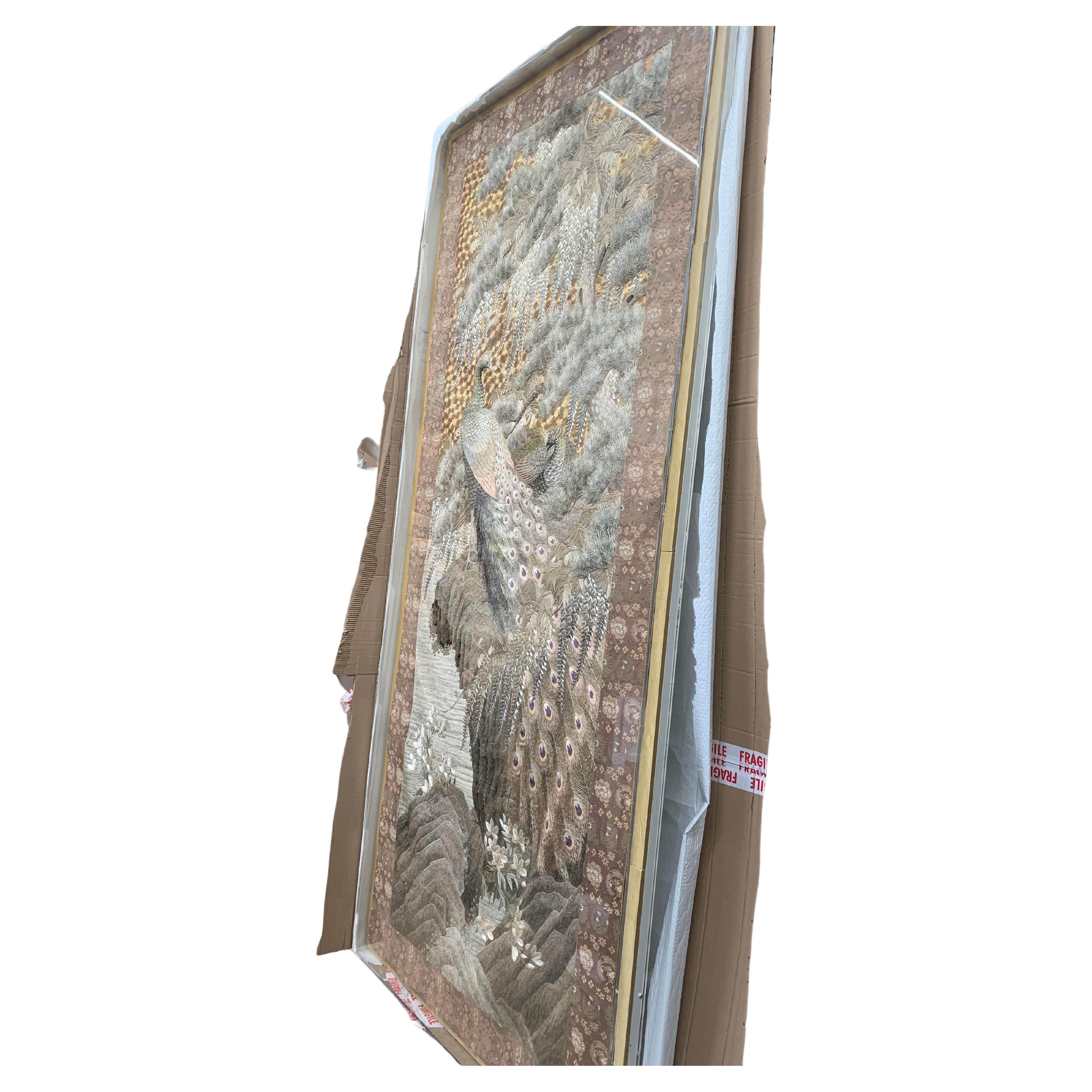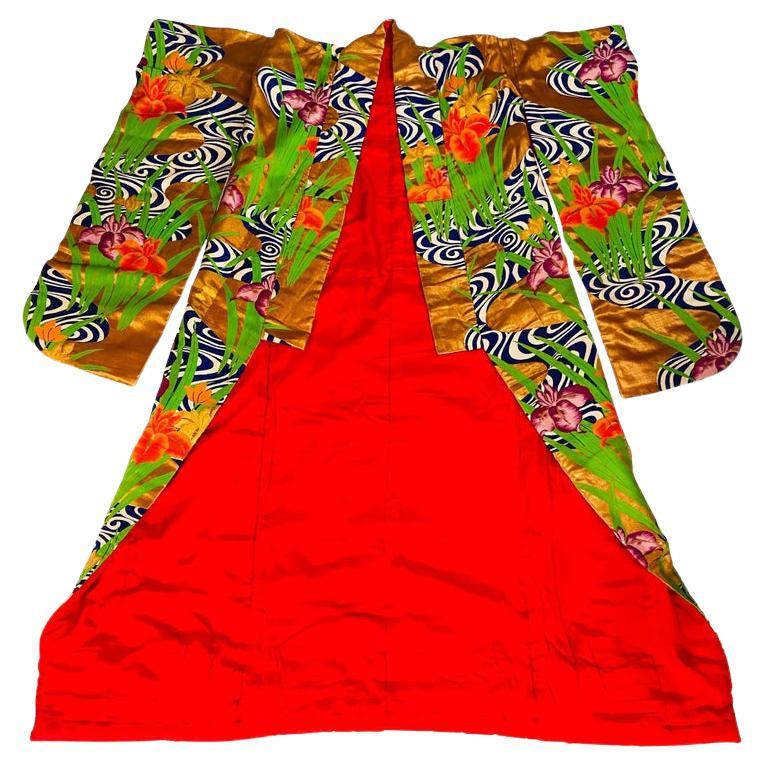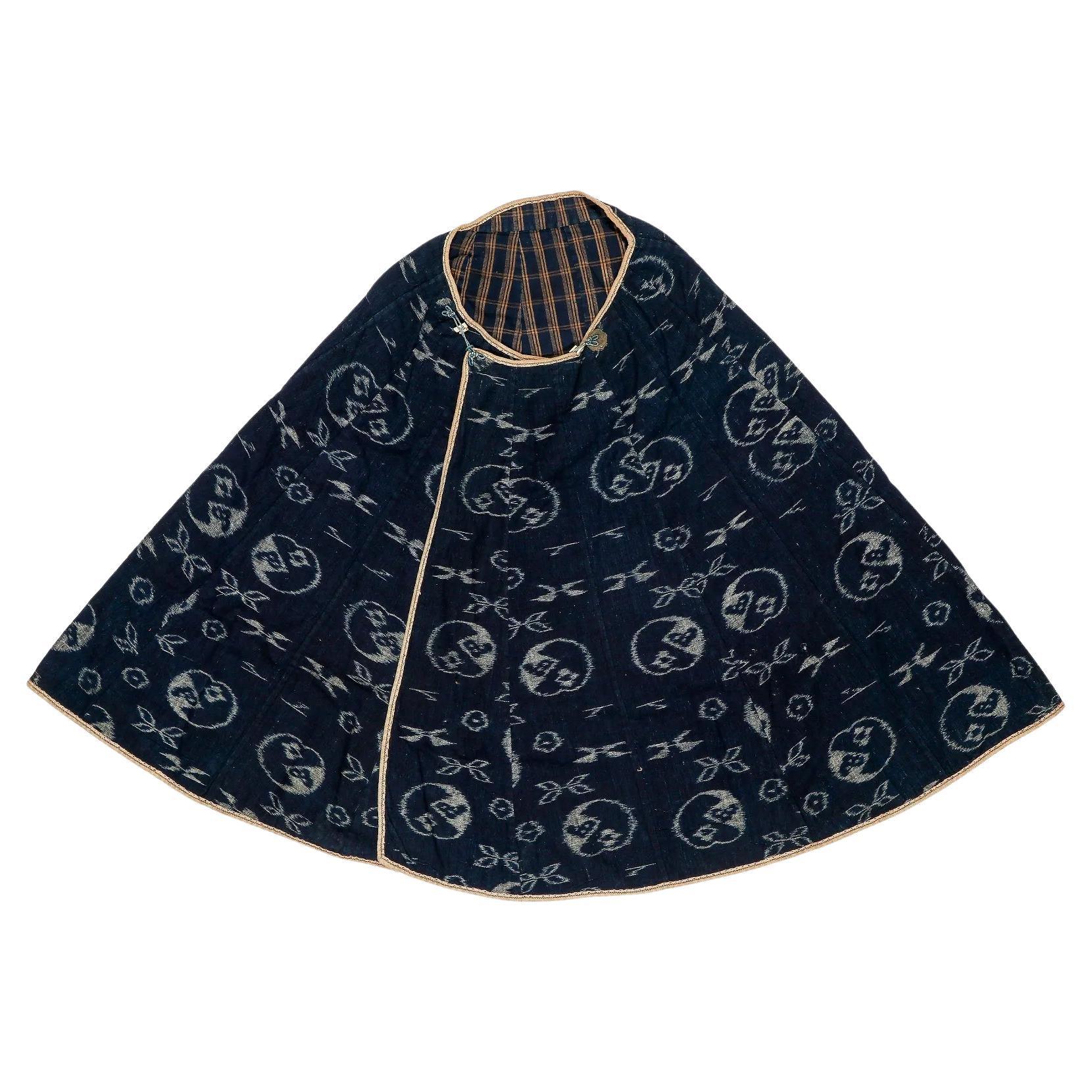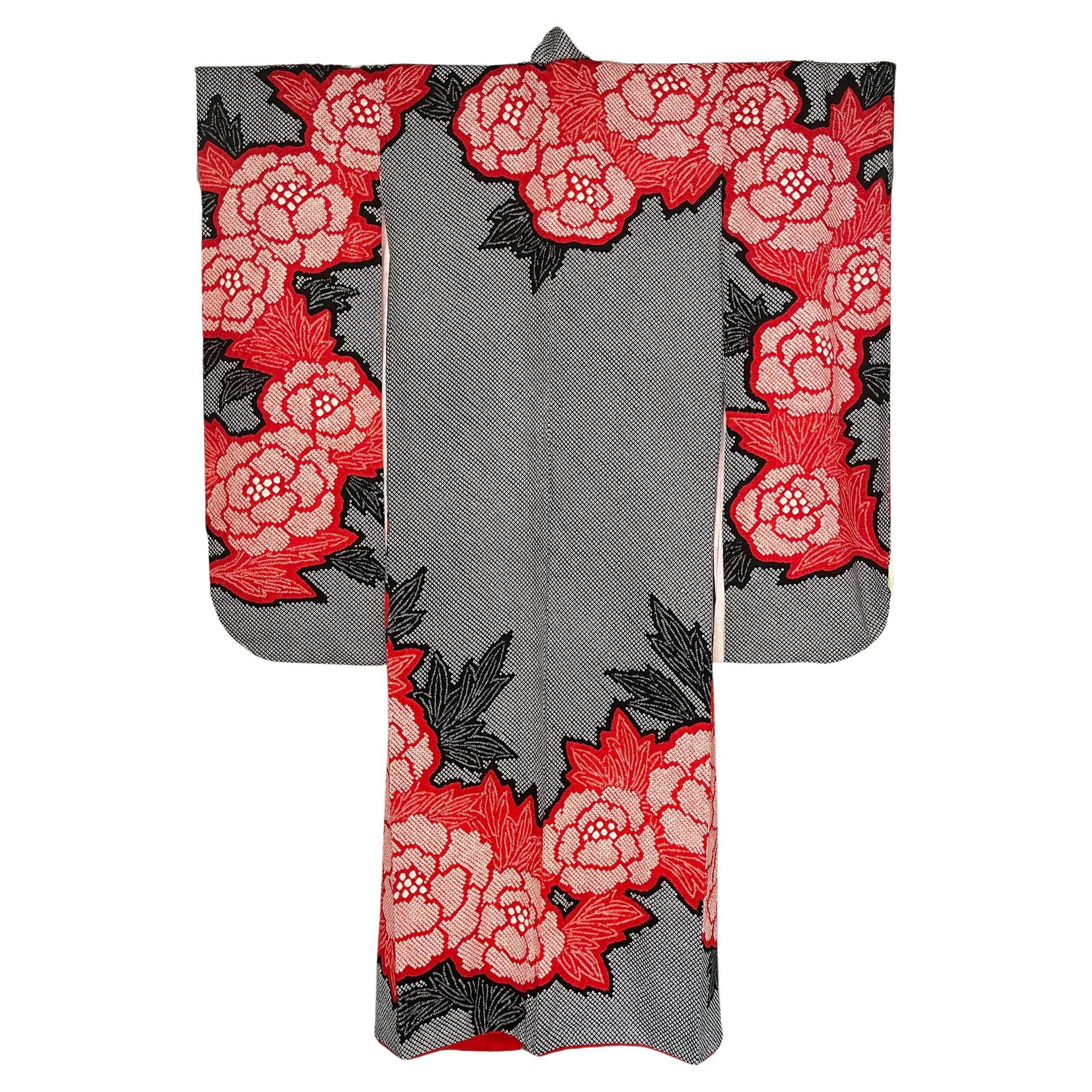Items Similar to Japanese Silk Textile by Iida Takashimaya Company
Want more images or videos?
Request additional images or videos from the seller
1 of 6
Japanese Silk Textile by Iida Takashimaya Company
About the Item
As part of our Japanese works of art collection we are delighted to offer this charming Meiji period 1868-1912 embroidery of a chin dog aside a spray of peacock feathers and by one of the most famous textile company’s of the period, the Iida Takashimaya company, the breathtaking and simply captivating detail of the silkwork demonstrates some of the finest possible stitching methods available at that time and not surpassed to this day, the silk picture is cushioned and housed within its original black lacquered wood frame and importantly bearing the original and scarce Iida Takashimaya factory label to the reverse, an absolute masterpiece from a golden period of textile production, this picture would light up the wall of any room particularly your Japanese themed space .
Provenance :
UK Collection .
Featured in – 2020 Vision of an enlightened ruler exhibition – plate 39
Literature :
There is little doubt that a major part of the phenomenon of Japanese works of art exploding onto the worldwide stage leading up to and during the Meiji period was bought about by the Textile manufacturers of Kyoto, the most recognized of which will undoubtedly be the Nishimura company, founded in Kyoto in 1670 as textile traders,
It was the 12th generation manager Nishimura Sozayemon (1855-1935) aged just 17 and remarkably adopted into the family as the son of a Chinese scholar who took the company to its dizzy heights. As early as 1873 just one year into his tenure the company were exhibiting at expositions and even during that early period the company picked up significant awards and medals with recognition both nationally and overseas , particularly in Paris in 1878 , thereafter the factory moved to new premises in Kyoto , presumably having outgrown their original site , this move coincided with the building of the new Imperial palace in Tokyo where Nishimura were commissioned to provide 64 embroidered wall panels . the highest accolade had surely now been achieved as “suppliers to the Imperial household” this was the ultimate marketing tool which was now used widely in the sales campaigns and specifically on the product labels , during the 1890’s the company continued to innovate and execute new techniques , they employed the finest artists and embroiderers taking the company from strength to strength , multiple gold medals and notable awards were achieved at various national and international expositions , there is little doubt that the appetite for Nishimura products were insatiable particularly in America and Paris where know traders were buying and or commissioning multiple items for their clients collections, and indeed their own gallery’s , make no mistake some of these incredible works of art would have been expensive items at the time , with the finest pieces commissioned for the clients of wealthy merchant traders and Imperial household members .
It seemed as if Sozayemon coupled with his accolade of supplier to the Imperial household had cornered this highly lucrative market ,this was the case certainly until the 1890’s when the company faced stiff competition from the new kid on the block ,Iida Takashimaya , a company founded in 1831 by Iida Shinshich I (1803-1874) as a small retailer of non silk drapery products , this modest shop called Takashimaya would through successive generations of the Iida family quickly rise to prominence as a major player on the worlds stage, Imperial household suppliers and ultimately stiff competition for the long established Nishimura company . Having only gained a licence for the manufacture and sale of silk products as late as 1855 the new generation led by Iida Shinshichi II began to make inroads into the Kyoto retail market supplying mostly clothing rugs and its speciality Fukusa, to the emerging middle classes , in 1877 Iida first exhibited nationally winning numerous awards.
Following the untimely death of Shinshichi II in 1878 the company passed into the hands of the remaining siblings headed up at this point by the daughter in law of the founder Iida Utako who continued development of domestic products but with an eye on the emerging decorative textiles market , winning awards at major national and international expositions , the growth was rapid and Iida were clearly begining to make inroads into the market once dominated by the Nishimura company, even head hunting Nishimuras finest artists to work for them, eventually in 1887 they too were commissioned by the Imperial household to supply amongst other items drapery and wall coverings for the new Imperial palace, this accolade resulted in two of Iida’s weavers being elevated to the honorable rank of “Imperial artist” followed later in the 1890’s with the Iida company officially recognized and now able to market themselves as “official manufacturers to the Imperial Household ” , had Iida outwitted their peers , clearly there was demand for two such important companies in what was at the time and clearly remains today a red hot market for arguably the finest textiles ever produced .
The above plotted history can offer only the briefest insight into an industry that simply took the audiences breath away when it launched onto the world stage during the latter part of the 19th century. For a more in depth study of Japanese textiles I would absolutely recommend “Threads of Silk and Gold “ a pioneering study of Japanese textiles that accompanied the first ever textile exhibition held outside Japan , and curated by Clare Pollard at the Ashmolean museum in 2012 .
As stated the finest products are as highly coveted today as they were during this innovative period though obviously much scarcer with the finest textiles now preserved in the world’s leading museums and collections , I sincerely hope you enjoy our modest sized high quality examples representing each of the two dominant company’s of the Meiji period .
Condition report :
The silk itself in remarkable condition , the cushions with minor creases.
Approximate Sizes :
Length : 26.75? 68 cm
Width : 21.5? 54.5 cm
Depth : 3.25? 8.5 cm
Free worldwide delivery and a certificate of authenticity are included in the price of this item.
- Creator:Takashimaya (Artist)
- Dimensions:Height: 26.75 in (67.95 cm)Width: 21.5 in (54.61 cm)Depth: 3.25 in (8.26 cm)
- Style:Meiji (Of the Period)
- Materials and Techniques:
- Place of Origin:
- Period:
- Date of Manufacture:1868-1912
- Condition:Wear consistent with age and use.
- Seller Location:Christchurch, GB
- Reference Number:1stDibs: LU8622234035522
About the Seller
5.0
Vetted Seller
These experienced sellers undergo a comprehensive evaluation by our team of in-house experts.
Established in 2011
1stDibs seller since 2023
Typical response time: 1 hour
- ShippingRetrieving quote...Ships From: Christchurch, United Kingdom
- Return PolicyA return for this item may be initiated within 14 days of delivery.
More From This SellerView All
- Monumental Japanese Silk Textile - Peacocks in Landscape.By TakashimayaLocated in Christchurch, GBAs part of our Japanese works of art collection we are delighted to offer this outstanding large scale Meiji Period 1868-1912 silk textile depicting a pair of peacocks within a lands...Category
Antique Late 19th Century Japanese Meiji Textiles
MaterialsGold
- Huge Japanese Silk Textile Goose In FlightLocated in Christchurch, GBAs part of our Japanese works of art collection we are delighted to offer this large scale framed Meiji Period (1868-1912) signed silk textile, the Kyoto artist has rendered a very l...Category
Antique 19th Century Japanese Meiji Textiles
MaterialsSilk
- Very Large Japanese Bronze Ferry Boat Okimono by SeiyaLocated in Christchurch, GBAs part of our Japanese works of art collection we are delighted to offer this most unusual large scale Meiji Period 1868-1912, bronze casting of a wooden ferry boat carrying passeng...Category
Antique 19th Century Japanese Meiji Metalwork
MaterialsBronze
- Japanese Silver and Mixed Metal Koro, Artist SignedLocated in Christchurch, GBAs part of our Japanese works of art collection we are delighted to offer this super quality Meiji Period 1868-1912, pure silver and mixed metal koro or incense burner, the heavy sil...Category
Antique 19th Century Japanese Meiji Metalwork
MaterialsMetal, Silver
- Large Japanese Ceramic Charger by Fukagawa Seiji CompanyBy FukagawaLocated in Christchurch, GBs part of our Japanese works of art collection we are delighted to offer this large Meiji Period (1868-1912) ceramic charger made under the banner of the Fukagawa Seiji Gaisha, a bre...Category
Antique Late 19th Century Japanese Meiji Ceramics
MaterialsCeramic
- Japanese Pure Silver Hawk Okimono – Musashiya Company (Ozeki)By MusashiyaLocated in Christchurch, GBAs part of our Japanese works of art collection we are delighted to offer this scarce pure silver Meiji Period (1868-1912) okimono of a hawk, artist signed Juiedo for the famous Musa...Category
Antique 19th Century Japanese Meiji Metalwork
MaterialsMetal, Silver
You May Also Like
- Japanese Indigo Kasuri Ikat Traveling CapeLocated in Atlanta, GAKnown in Japanese as Bozugappa (priest's raincoat), this cape-like garment was worn by the travelers in Japan circa late 19th century to early 20th century (end of Meiji period). Derived from the cape worn by the Portuguese missionary, who first arrived in Japan in mid-16th century, this type of cape was originally reserved for the Japanese military...Category
Antique 1890s Japanese Meiji Textiles
MaterialsCotton, Linen
- Embroidered Red and Green Japanese Silk Ceremonial Kimono, 1940'sLocated in Plainview, NYAn early 20th century exceptional Embroidered Japanese Ceremonial Kimono featuring marvelous handmade floral pattern in vivid colors including red, blue and green on gold. The interi...Category
20th Century East Asian Japonisme Textiles
MaterialsBrocade, Silk
- Saki-Ori Farmers Coat, Northern Japan, Meiji PeriodLocated in Point Richmond, CASaki-ori farmers coat, Northern Japan, Meiji period A very heavy and substantial saki-ori coat, made of cotton with an indigo kasuri lapel. Several patches of hand sewn stitching ...Category
20th Century Japanese Meiji Textiles
MaterialsCotton
- Fine Japanese Couture Shibori Silk Furisode Kimono with Under GarmentLocated in Atlanta, GAA spectacular Japanese silk kimono set with an outer furisode and an inner garment circa 1960-80s. The long sleeve furisode is of couture quality and made m...Category
Vintage 1960s Japanese Modern Textiles
MaterialsSilk
- Japanese Buddhist Monk Priest 7 Column Silk Brocade Kesa Ceremonial Temple RobeLocated in Studio City, CAA wonderful, beautifully ornamented and somewhat rare fully intact Japanese Buddhist monk/ priest's Kesa ceremonial silk robe featuring various colorful birds in flight. Kesa (which came from the Chinese word "kasaya") robes have been handmade/handstitched by monks/priests as an act of devotion as ceremonial robes for centuries in various Asian cultures (Japanese, Chinese, Korean, Vietnamese, Indian, etc.). The kesa is a rectangular garment designed to be worn over the left shoulder (see example image). The robes are made (often in a patchwork column pattern ranging from five, seven, nine or more pannels) specifically for fully ordained Buddhist monks, priests and nuns and are made from donations of exquisite textiles from wealthy patrons of Japanese Buddhist temples. The robes were used in daily ceremonies, temple gatherings, and private meditation. Antique Kesa robes...Category
Mid-20th Century Japanese Showa Textiles
MaterialsTextile, Brocade, Silk
- Japanese Edo Buddhist Monk Priest 7 Column Silk Brocade Kesa Ceremonial RobeLocated in Studio City, CAA wonderful, brightly coloured and somewhat rare fully intact Japanese Buddhist monk/ priest's Kesa ceremonial silk robe. Kesa (which came from the Chinese word "kasaya") robes have been handmade/handstitched by monks/priests as an act of devotion as ceremonial robes for centuries in various Asian cultures (Japanese, Chinese, Korean, Vietnamese, Indian, etc). The kesa is a rectangular garment designed to be worn over the left shoulder (see example image). The robes are made (often in a patchwork column pattern ranging from five, seven, nine or more pannels) specifically for fully ordained Buddhist monks, priests and nuns and are made from donations of exquisite textiles from wealthy patrons of Japanese Buddhist temples. The robes were used in daily ceremonies, temple gatherings, and private meditation. Antique Kesa robes...Category
Antique 19th Century Japanese Edo Textiles
MaterialsTextile, Brocade, Silk
Recently Viewed
View AllMore Ways To Browse
Antique Silk
Silk Antique
Antique Company
Antique Companies
The Antique Company
Antique Furniture Companies
Antique Furniture Company
The Antique Furniture Company
Black Textiles
Black Textile
International Furniture Company
Textile Light
Antique Products
World Textiles
Small Textile
The Lacquer Company
Red Textile
Long Textiles





